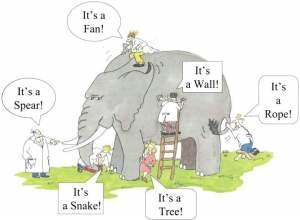The parable of the blind men and the elephant is probably the most widely known and the most loved of all the world’s parables. By far the earliest version of this parable is attributed to the Buddha and its appeal is due to how well it makes its point, its striking juxtaposing of man and beast and its use of gentle humour.
The parable goes something like this:
Some monks in Sāvatthi noticed a group of non-Buddhist monks quarrelling with each other about some philosophical or theological issues. Later that day, they told the Buddha what they had seen, and he said, ‘Wanderers of other sects are blind and unseeing. They don’t understand the good and the bad and they don’t know the true and the false. Consequently, they are always quarrelling, arguing and fighting, wounding each other with the sharp weapon of the tongue.’
Then the Buddha related his famous parable. ‘Once, here in Sāvatthi, the king called a servant and said: “Call together all the blind men in Sāvatthi.” Having done as the king commanded, the king then said to the servant, “Now show the blind men an elephant.” Again the servant did as the king commanded, saying to each, in turn, as he did, “This is an elephant and this is its head. This is its ear. This is its tusk. This is its trunk. This is its body. This is its leg. This is its back. This is its tail. This is the end of its tail.”
Afterwards, the king addressed the blind men saying, “Have you seen an elephant?” and they replied, “We have sire.” Then the king asked, “And what is an elephant like?”
As you can see from the picture, their personal version of ‘what an elephant is like’ depended on which part of it they were presented with. They began to quarrel saying, “Yes it is!” “No, it isn’t!” “An elephant is like this!” “An elephant is like that!” until eventually, they began fighting with each other.’
Having told this story, the Buddha summed up its meaning in a little verse – ‘even some monks and priests are attached to their views and, having seized hold of them, they wrangle, like those who see only one side of a thing.’
The key to understanding the meaning here is in the last line; “seeing only one side of a thing” (ekaṃga dassino). This is simply advice about how to form a more complete, more accurate view of reality, and here, the Buddha is suggesting one important point – that we should not mistake the part for the whole.
I’ve often done a similar exercise in my training room, to convey the same message. This time, simply for logistic reasons (elephants are not easy to come by) I break the delegates into three groups and show one group a picture of a square, one group is shown a rectangle and the last group is shown a triangle. Each group is asked to explain what they have seen. Of course, they always come up with simple ‘geometric’ style descriptions, which, much to their disbelief, I tell them is incorrect. As you might imagine, like the blind men in the Buddha’s parable, they disagree and argue that they are right.
Eventually, and in order to help them to understand my point, I show them all a picture of a wedge of cheese. The end of which is a square, the side a rectangle, and the top a triangle. The concept being that, for each of us, our perception is our own truth.
So, whether you use elephants or cheese to remind you, be sure that, when you are faced with differing opinions on something, there may be other viewpoints to be considered that will give a truer and more complete picture of reality.


